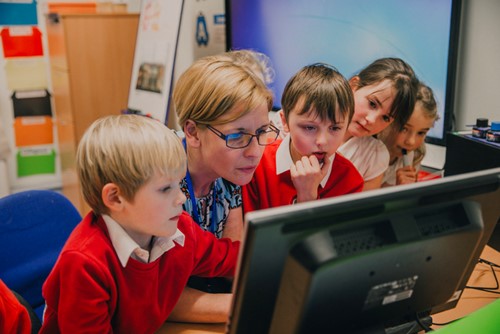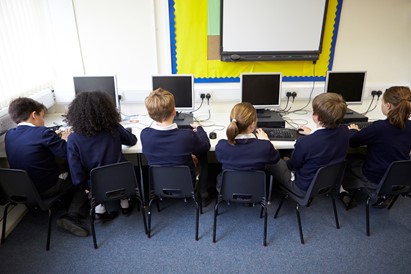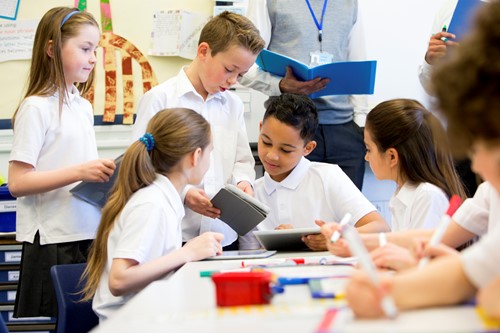Practical Strategies for Enhancing Collaboration, Critical Thinking, and Engagement in the Classroom
Group work in the classroom, especially when integrating ICT, offers several benefits for students, including enhanced collaboration, increased engagement, and improved problem-solving skills. However, these benefits can be hindered by challenges such as unequal participation or varying levels of ICT proficiency. Below are four key strategies to overcome these common group work problems and fully leverage the benefits of group work in the classroom, with examples from the ICT in Education Teacher Academy that highlight how these strategies can be successfully applied.
1. Encouraging Collaboration and Communication
Problem: A common challenge in group work is ensuring all students are actively participating and communicating effectively.
Solution: Use ICT tools that promote group collaboration, such as shared digital whiteboards or online discussion platforms. Tools like Google Docs or Padlet allow students to contribute and edit content in real time, fostering teamwork. Encouraging children to use digital storytelling apps such as Book Creator (for early years) or using a Bee-Bot to work collaboratively on a coding challenge are excellent ways to engage students while enhancing their communication skills.
| Benefit of Group Work | How It’s Achieved in the Membership |
|---|---|
| Collaboration & Communication | Tools for real-time collaboration (e.g., Padlet, Book Creator, Bee-Bot challenges) |
| Structured lesson plans for group interactions |
2. Handling Differentiation of Skills
Problem: Different students in a group often have varying levels of ICT proficiency, making it difficult to ensure that all students are both challenged and supported appropriately.
Solution: Group students based on their skill levels and use ICT differentiation strategies. In the ICT in Education Teacher Academy, lesson plans often include different levels of ICT tasks (basic, intermediate, advanced), such as simple typing games for beginners or more complex tasks like coding with Bee-Bots for advanced students. This ensures that all children can engage with the content at their level, providing opportunities for growth without overwhelming them.
| Benefit of Group Work | How It’s Achieved in the Membership |
|---|---|
| Differentiated Learning | Activities at multiple levels of differentiation (e.g., Bee-Bot) |
| Lesson plans with tiered ICT tasks |
3. Promoting Critical Thinking and Problem-Solving
Problem: Students may struggle with complex problem-solving tasks, especially when using ICT tools they are unfamiliar with.
Solution: Use ICT tools that stimulate problem-solving and critical thinking. Activities like taking apart a non-working computer tower to identify its components (as seen in the membership resources) or guiding students through coding challenges with programmable toys such as Bee-Bots offer students hands-on opportunities to apply their learning. These tasks encourage children to think critically and collaboratively to solve real-world problems.
| Benefit of Group Work | How It’s Achieved in the Membership |
|---|---|
| Critical Thinking & Problem-Solving | Problem-solving tasks using tools like Bee-Bots or non-working tech devices |
| Interactive challenges that require group input and collaboration |
4. Fostering Engagement and Motivation
Problem: Maintaining students' engagement during group tasks, especially when using technology, can be challenging, particularly if the task is perceived as repetitive or too easy.
Solution: Engage students with creative, dynamic ICT activities that relate to their interests. For example, activities like creating nature-inspired digital stories using iMovie or QR code nature hunts where children use tablets to scan QR codes and discover fun facts encourage curiosity and make the learning process more interactive. Students are more likely to stay motivated when the tasks are both fun and educational, thus demonstrating the benefits of group work in the classroom by keeping students engaged and working together toward a shared goal.
| Benefit of Group Work | How It’s Achieved in the Membership |
|---|---|
| Engagement & Motivation | Fun, interactive ICT tasks like QR code hunts and digital storytelling |
| Creative use of tech tools for meaningful play |
By adopting these strategies, educators can overcome common ICT group work challenges, ensuring that all students are supported and engaged. The ICT in Education Teacher Academy offers a wealth of resources that help teachers integrate these strategies into their classrooms effectively, enhancing the benefits of group work in the classroom.

How to Improve Group Work in the Classroom
Effective Strategies for Enhancing Collaboration and Engagement Among Students
Group work is a valuable educational approach that encourages students to collaborate, communicate, and problem-solve together. However, making group work truly effective in the classroom can be challenging without a clear understanding of the strategies that best support students. Below, we will explore some of the most effective group work strategies for students and offer practical tips on how to improve group work in the classroom.
1. Establish Clear Expectations and Roles
A major factor in effective group work strategies in the classroom is ensuring that all students know what is expected of them. When students understand their individual roles, they are more likely to contribute to the group's success. Begin by clearly defining each student's responsibilities within the group, which helps prevent confusion and ensures that every group member is actively involved. Consider using role assignments like researcher, note-taker, or presenter, or encourage students to define their roles at the beginning of the activity.
When to Use: This strategy is especially useful in larger groups where tasks may become overwhelming without clear division of labor.
Source: Edutopia - Effective Strategy for Group Work
2. Foster Communication and Collaboration
One of the benefits of group work in the classroom is that it provides students with the opportunity to develop their communication skills. Promoting open dialogue and ensuring students are comfortable expressing their ideas is key. Group members should be encouraged to actively listen to one another, ask clarifying questions, and work together to find solutions. Creating a space for collaborative brainstorming helps students practice teamwork in a meaningful way. Digital tools such as Google Docs or shared whiteboards can further facilitate collaboration by allowing multiple students to contribute to the work simultaneously.
When to Use: This strategy is ideal for projects that require input from all group members or when students are working with unfamiliar content that may benefit from a diverse set of perspectives.
Source: Teaching at UNSW - Ideas for Effective Group Work
3. Monitor Progress and Provide Feedback
To ensure that students remain on track and are not veering off course, regular progress checks are important. Teachers can monitor group dynamics by circulating around the room and observing how groups are working together. Providing timely feedback helps students improve their group collaboration and addresses any potential issues before they become larger problems. Feedback can be both positive and constructive, helping students understand what they are doing well and where they can improve.
When to Use: This strategy is particularly effective when groups are working over extended periods of time, such as for long-term projects or assignments.
Source: University of Waterloo - Implementing Group Work
4. Encourage Reflection and Self-Assessment
After completing a group project, it's crucial to give students the opportunity to reflect on their experience and assess their performance. This can be done individually or as a group discussion. Students should consider what worked well, what could have been improved, and how their group dynamics contributed to the success (or failure) of the project. Reflection helps students internalize the lessons learned from group work, and self-assessment encourages them to take responsibility for their contributions.
When to Use: This strategy is best used after the completion of a group project to help reinforce the learning experience and promote self-awareness.
How the ICT in Education Teacher Academy Can Support Your Group Work Goals
Implementing these group work strategies for students in the classroom can significantly improve student engagement, collaboration, and overall academic performance. However, as educators, finding effective solutions for group dynamics and ensuring that all students are engaged can often leave us with questions.
Being part of a professional community like the ICT in Education Teacher Academy offers the invaluable benefit of having answers to these questions at your fingertips. With 24/7 access to expert resources and a supportive network of educators, you can quickly find solutions to the challenges of group work in the classroom. Whether you're looking for innovative strategies or seeking feedback on your approach, the community aspect of the academy provides real-time support.
Additionally, the membership provides structured lesson plans that are specifically designed to promote effective group work strategies in the classroom, allowing you to implement the right techniques with ease and confidence. Whether you're looking to foster collaboration or improve problem-solving skills within groups, you'll find tailored resources and tools that align with your classroom needs.
By incorporating these strategies, you can create a classroom environment where group work becomes a tool for student empowerment, learning, and growth. And with the support of a dedicated professional community, you can ensure that your approach to group work in the classroom is continually evolving to meet the needs of your students.

4 Group Work strategies in the classroom
When it comes to ICT work in the classroom for students, this usually means some form of collaboration or group work. Collaborative ICT work is not an aspect that teachers should fear. To begin with, students should learn real-world practices and with an ever-changing ICT landscape in society at our doorstep, it is important that this occurs. This is a method that teachers therefore should embrace in the classroom.
In primary schools, in particularly, collaborative work brings many new skills to students such as teamwork and communication skills. Research has also shown this enhances their learning experiences as they talk and discuss any issues involved. However, it also comes with some baggage issues so to speak as well. Below are my group work strategies in the classroom.
How do you determine the individual achievement of students in a group?
The first strategy that you should use is something that most teachers do naturally in the classroom – they observe! Observing students in their ICT work is a great way to assess student capabilities. Any observation made should also then be supported by records kept by the teacher. These records of your own observations can be tested against what you may ask the students about their work to identify the contributions made.
Teacher intervention
Another method you can use which is important is to intervene. When doing so remember that it shouldn’t be negative or critical, but supportive and formative (e.g. “That’s a good start. Can you see disadvantages of doing it this way…etc). As a teacher you should be able to draw from these responses to your questions a feeling an individual student’s understanding. It is also important to note here that assessment should not be a “one-off snapshot” as Richard Ager (2007) puts it. It needs to be a continual process that will gradually put together the pieces of the individual student’s abilities.
For these strategies to be successful, however, it is best that you as the teacher create the groups yourself rather than letting students form their own. Research has shown (Kennewell et al., 2000) that schools that implemented this approach were effective in developing student ICT capability. When pairing students, it is best to do so by taking in to account the following factors:
- Differences in ICT capability - when you decide to pair students together, it is a good group work method of teaching to put a less capable child with a mentor who is more capable and experienced so that both children will learn. The more capable child will learn to be a mentor and be able to express their ideas clearly over time;
- Personalities of the students - some students may be more dominant than others so when pairing be mindful of this so that this does not lead to disagreements. Pair the dominant students together instead.
- Sex - single sex pairs generally work well together, however, some boys may tend to take turns rather than work together. It is said that pairing boys with girls can have benefits.
- The nature of the task - decide if both children will be collaborating on one outcome, or will they be assisting each other with their individual pieces of work?
Finally, it has been discovered in the past by successful primary teachers that by using the so-called ‘student ICT experts’ in the class to their advantage, students can learn from their peers. Students who are more capable can develop clearer concepts about the processes by having to analyse what they do in order to explain it to their friends. A potential problem that may arise is that it could distract these students from their own work. If this is the case, research has found that by using mixed ability pairs, particularly when there are important ICT learning objectives, can help minimise such a problem.

Building on your Group Work Strategies
Besides the above group work strategies in the classroom when using technology in the classroom, there are also other methods that you can apply and embed that are quite effective.
Group work in the classroom is great for 21st century skills such as collaboration and cooperation between students. It certainly not a lazy option as you to plan for it effectively and ensure that it is executed well. Yet, despite all your efforts things may not work out well for you.
According to Alex Quigley, the basis for the rules for group work in the classroom would include:
- Having clearly defined tasks, with sharp timings and with the appropriate tools organised;Have clearly defined group roles;
- Have clear ground rules for talk, listening and fair allocation of workload etc;
- Target your support and interventions throughout the task, but make them interdependent of one another, not dependent upon you;
- Always be prepared to curtail group work if students don’t follow your high expectations.
Research from UNSW have indicated that the group work method of teaching has many benefits such as:
- Allows students to become active participants in their learning;
- Helps students develop skills valued by employers (such as problem solving, negotiation, conflict resolution, leadership, critical thinking and time management);
- Exposes students to diverse ideas and approaches;
- Acknowledges and utilises individual students' strengths and expertise;
- Through discussion, helps students articulate their ideas, refine concepts and develop interpersonal and communication skills;
- Allows students to experience situations that resemble the workplace, e.g. authentic real world projects, and;
- Facilitates a deeper understanding of course content.
The other group work strategies in the classroom that will follow are said to be effective:
- ‘Think-pair-share’ and ‘Think-pair-square’
- Snowballing or the Jigsaw method
- Debating
- Project-based learning
- Group presentations
- ‘Devise the Display’
- Gallery Critique
- Socratic Talk
- Master modelling
How to implement
As said earlier, group work in the classroom can be effective but you need to plan for it to be so. Your group work method of teaching needs to ensure that it is motivating and that it encourages active learning.
Students need to deploy critical thinking, communication, and decision-making skills.
To prepare for the group work method of teaching you first need to:
- Think carefully about how students will be seated such as what has been mentioned earlier in relation to technology use and ICT capability.
- Insist on professional, civil conduct between and among students.
- Talk to students about their past experiences with group work.
As a teacher, you may also face challenges of group work in the classroom such as the following:
- Lacking focus – you can ask students to talk through the task they are trying to complete.
- Unequal contribution – as discussed earlier, you can assign roles to students and also rotate these roles.
- Personal issues – there may be conflict between students and you can overcome this by encouraging group members to respect and acknowledge ideas, consider how they can improve their communication, work through the cause of the conflict as a group and understand that working in a team may require negotiation and compromise.
- Poor communication – encourage group members to clarify anything they don’t understand, ask questions, make requests and speak respectfully.
The use of group work strategies in the classroom such as the above can provide you with reassurance that you have planned adequately regardless of how well the outcome may be. As a teacher, you choice should then be reassess these strategies for the students you used them with and amend them in order to make further improvements on later group work in the classroom.

How to Group students in the Classroom Effectively?
Group work is an essential part of any student-centred classroom. In the 21st century classroom that is expected to house various types of technology in the classroom, collaboration and cooperation amongst students can be facilitated through good technology teaching strategies.
Teachers who plan for technology integration in the classroom also plan to group students in ways in which they can see positive results. Children’s overall learning experiences are boosted and they are more engaged in their learning leading to an increase in academic improvement, more productivity and a higher self-esteem.
Different way of grouping students when integrating technology in the classroom
Here are a number of ways for you to learn how to group students in the classroom when integrating technology.
- Differences in ICT capability – group students who are more capable with ones who are less capable. The more experienced can act as a mentor and the less experience can learn more if the mentor has a clear idea of the role. At times, you may need to interact to reinforce this role.
- The personalities of the children – some students are more dominant than other and if there is a dominant child in the group this could lead to disengagement from the task by the other. It is best to pair the dominant students together.
- Sex – single-sex pairs tend to cooperate more successfully. However, you may find that pairs of boys tend to take turns rather than work together. In younger children, the gender mix is less important than in older children. Pairing boys with girls can have benefits although boys are less inclined to benefit when working with girls on language activities. Girls themselves will benefit when working with boys on spatial tasks.
- Nature of the Task – this needs to be considered in your planning. Decide whether they will be collaborating on one outcome or will they be assisting each other with their individual pieces of work?
Key issues to Overcome
When planning for technology integration in the classroom, there will be a number of issues affecting the assessment of ICT capability. Any use of ICT is largely practical and so it is difficult to gather ephemeral evidence of the children’s responses to tasks and activities. As much technology integration is done through the grouping of students 2 particular areas of consideration needs to be addressed in your planning.
Children working in pairs
Computer-based activities actually promote collaborative work more than any other classroom activities. At times some pairings can lead to an unequal sharing of responsibility or effort. You may have already noticed that in some groups there are keyboard-hoggers who seldom allow their partner access to the computer and then there are those who are more than happy to sit back and let their partner do the work for them.
Additionally, there are those students who lack confidence or experience and are not comfortable exposing their perceived inadequacy to public scrutiny. Use these technology teaching strategies to make sure that both children have an equal opportunity to contribute to an activity:
Give the children specific roles or tasks when engaged in an activity – some activities lend themselves to the allocation of roles. Signal changeovers regularly during a lesson to ensure the pairs get equal access – this approach may be more suited to younger children.
Train the children in paired working – the inexperienced children could be supported through peer tutoring. If you decide to use this approach, it is important that the children are briefed on their roles.
Prepare on-and-off computer tasks during the ICT activity – have an off-computer task running alongside the computer-based task.
It is difficult to determine what the child has done and what the computer has done for the child
This can be overcome by either talking to the children or asking the older child to write a reflective report about the approach they used for an activity. You could also use a self-assessment sheet that encourages them to reflect on the extent to which they have developed new knowledge and skills. This strategy could be used as the basis for discussions or more comprehensive commentaries on the different methods they applied.

Unlock the Full Potential of Group Work in the Classroom
Effective group work in the classroom is crucial for fostering collaboration, critical thinking, and communication among students. To make group work successful, it's essential to set clear expectations, assign roles, and provide opportunities for regular feedback. Encouraging open communication, differentiating tasks based on skill levels, and using ICT tools like Google Docs and Bee-Bots can further enhance group dynamics and problem-solving skills. But ensuring all students are engaged and contributing equally can be a challenge.
That’s where the ICT in Education Teacher Academy can make a difference. With structured lesson plans designed for collaborative group work, real-time support from a dedicated community, and access to expert resources, the membership helps you seamlessly implement these strategies in your classroom. Whether you’re seeking guidance on managing diverse skill levels or need ideas for engaging ICT activities, the academy provides the tools and support you need to succeed.
